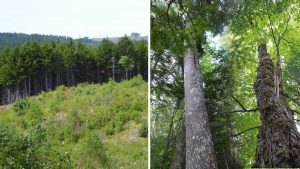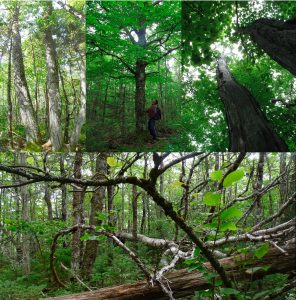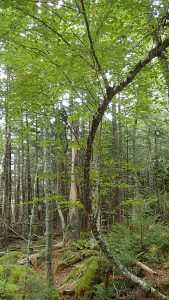To be more specific: Whats wrong with clearcutting the Acadian Forest in Nova Scotia?
Note, Mar 4, 2019: NSDNR/L&F no longer use the word “clearcut”, but the practice goes on, described as “Overstory Removal” and/or “Variable Retention”. View link.
Outside of Nova Scotia, apparently, “we spend 80 to 150 years growing a tree in Canada – some of the longest growth rates in the world”… according to Dr. Trevor Stuthridge of FP innovations.

Two approaches to forestry in Nova Scotia. One produces high value wood as well as sequestering carbon, providing habitat for wildlife and peace of mind to visitors.
I am a bit skeptical about the generality of that statement but regardless, it clearly does not apply to Nova Scotia where we are cutting on rotations of 40-60 years (and even less). There are a lot of other factors that make Nova Scotia exceptional and clearcutting particularly detrimental.
1. Nova Scotia’s forests are amongst the most, if not the most, intensively harvested in Canada, currently and historically. Read More.
The volume per hectare harvested from NS forests has been cited as the lowest in Canada (95m3/ha compared to 124 for Ontario, 234 for Saskatchewan, 394 for B.C.; Newfoundland and N.B. are also low at 100 m3/ha each)* so more land is harvested per unit of product in Nova Scotia compared to the rest of Canada.
OK, but can our forests “take it”?
NO.
2. Nova Scotia has some of the naturally poorest soils in North America and Europe, most notably the Gibralter soils which cover much of SW Nova Scotia.
As well, Nova Scotia is a high rainfall area and has generally shallow soils over hard bedrock making the soils highly susceptible to enhanced nutrient losses following clearcutting. As in the humid tropics, forests still grow on these poor soils, but maintenance of productivity is dependent on tight nutrient cycling in the organic horizons and within the vegetation.
The base-poor, acidic nature of the bedrock has made SW Nova Scotia especially susceptible to even moderate levels of acid rain, resulting in severe degradation in habitat for salmonids and other aquatic life. Loss of calcium in the forested soils is likewise probably contributing to declines in ecosystem health and biodiversity as reported elsewhere. Read more.
NSDNR has finally acknowledged that such losses are exacerbated by clearcutting and found that “1/4 to 1/2 of the assessed plantation sites have non-sustainable MMAI yield expectations…(read more) yet we forge ahead with the cutting of the Western Crown lands.

Old Growth hardwood stand (red oak/yellow birch/red maple) on granitic, nutrient-poor drumlin in the Five Bridge Lakes Protected Wilderness Area.
Diverse, productive forests can develop on such soils, and have in the past but it takes time, hundreds of years at least, possibly much more and if some critical thresholds are crossed, perhaps not again (as in much of Scotland). We can still harvest wood from our native forest, but not on the scale and intensity that we are now.
3. The Acadian forest that predominates on Nova Scotia landscape is not boreal forest, so the clearcut/even-aged management model that is said to simulate natural disturbance (mostly fire) in the boreal forest does not apply in NS (except in a limited area of fir-dominated forest in Cape Breton where the disturbance is budworm); clearcutting changes rather then maintains the natural forest in Nova Scotia. NSDNR claims that it manages forests to simulate natural disturbances, but the numbers do not back that up. Read more
Some of the more deleterious impacts of clearcutting Acadian forest:
(i) Because of the extent of clearcutting on 40-60 year (or even less) rotations we have drastically reduced habitat for species associated with older forests; and most of what remains is highly fragmented. Read more.
Also view: Scorched Earth by Bob Bancroft in Saltscapes, 2011. A quick, readable overview by a respected Nova Scotian elder who knows well our forests and their inhabitants. In Wealth of fauna call N.S. forests home CH Sep 12, 2014) Bob elaborates on habitats and habits of wildlife in older forests. As we cut vast tracts of forested land at 50 year intervals, we are losing many of these species locally, eventually to be lost province-wide, and contribute towards global extinctions. We do not need to.View more info on the flora and fauna and related conservation issues under Natural History, and its subpages: Forest Vegetation, Conservation, Conservation Links, NSDNR Old Forest Policy.
(ii) The “borealized forest” that is promoted by clearcutting and use of herbicides is NOT the one we should be choosing to adapt to climate change; rather we should be promoting and augmenting the natural Acadian forest with species from the south. Read more
(iii) Because of the extent of clearcutting on 40-60 year (or even less) rotations we have drastically reduced many other “ecosystems services” – those things that natural systems do for us that we end up paying for when we lose them. Two key ones: carbon sequestration (uptake and retention of CO2, a greenhouse gas); and the recreational/psychological values of the Acadian forest that are not provided by clearcut forests.
For more about carbon sequestration by the Acadian forest, view Mitch Lansky’s Double Bottom Line.
I think most of us are keenly aware of the social/psychological values that are lost when we clearcut forests. The impact is exacerbated in Nova Scotia by our dispersed population in rural areas combined with a high density of clearcutting.
Clearcutting may be the most appropriate harvesting system in the Canadian boreal forest (although even that view requires modification); it is clearly not the most appropriate tool for the majority of the Nova Scotia forests. The one forest type where there may be some justification for clearcutting: the white spruce/balsam fir dominated forests that have come back on land once cleared for agriculture and then abandoned, although the classic study by Drinkwater (1957) advised 2 or 3-stage shelterwood cuts and only small clearcuts. However, even there, patience and some intervention could allow more of the hardwoods and mixed Acadian forest to eventually return.

Does compaction by clearcutting affecting >10% of the area impact future species composition and productivity?
I also wonder if there isn’t a lesson to be learned from that particular successional sequence (mixed Acadian forest–>farmland–>white spuce/fir—?—>mixed Acadian forest). Is it compaction from farming that favoured white spruce/fir and slowed down the succession to hardwoods or mixed Acadian forest? Are there implications for the future species and productivity of the 10-70% of clearcut land** that is impacted by large vehicles and heavy machinery involved in clearcutting?
Is NSDNR looking at such impacts? Are they included in their long term strategic modelling of wood supply? I would like to think so. In the meantime, clearcutting continues unabated.
—————————————-
*Table 10 in Canada’s Forests at a Crossroads: An Assessment in the Year 2000. Global Forest Watch.
**The impact of heavy traffic on forest soils: A review Martina Cambia et al. Forest Ecology and Management Volume 338, 15 February 2015, Pages 124–138
—————————————–
For an industry perspective, see Forest Products Association of Nova Scotia: Harvesting
For a different view:
Clearcutting our losses – The long history of Nova Scotia sacrificing its forests to big pulp, and why it has to end.
By Joan Baxter in The Coast, Oct 5, 2017
Some related posts
A disturbing level of forest disturbance in the Highlands
October 24, 2016
Mimicing natural disturbances and sustaining natural ecosystem structure and function in Nova Scotia
November 11, 2016
How much forestry in Nova Scotia maintains mixed, multi-aged Acadian forest?
January 23, 2017
Concerns about clearcutting in Digby Co.
March 7, 2017
Annapolis County concerned about impending WestFor agreement
March 8, 2017
Halifax Co. clearcutting taking its toll
March 10, 2017
More cutting near Nova Scotia Protected Areas…now Loon Lake Nature Reserve
May 24, 2017
Sadness in the voices of Nova Scotians commenting on clearcutting
May 25, 2017
Latest Crown land allocation includes residual Deer Winter Area
June 25, 2017
Clearcut Nova Scotia continued..4July2017 & highgrading at the landscape level
July 6, 2017
Clearcut Nova Scotia continued..17July2017 & how much wood can be harvested from one hectare
uly 21, 2017
Crossland: federal Migratory Birds Convention Act ignored as habitat is cut for chips
July 22, 2017
Wasted Wood on Crown land in eastern Nova Scotia
Aug 12, 2017:
If we run into some good woods, we must be off of Crown land
Sep 8, 2017
Clearcutting is putting tourism at risk says President of Nova Scotia Tourism Industry Association
Sep 22, 2017
More cutting near protected areas in Nova Scotia, now the Tobeatic
Oct 10, 2017
On Forest Degradation (vs Deforestation)
Forest Degradation: Canada’s Skeleton in the Closet
Joshua Axelrod on NRDC, sep 21, 2017
Canada’s degradation of pristine, intact forests leads world
Emily Chung · CBC News · Posted: Sep 05, 2014
Global Forest Watch 2014
“The countries with the highest total area of degradation since 2000 are Canada, Russia, Brazil, the United States and Bolivia”
“Almost 95 percent of IFLs [Intact Forest Landscapes] are concentrated within tropical and boreal regions. Just three countries—Canada, Russia and Brazil—contain 65 percent of the world’s remaining IFLs. These countries also account for more than half of all IFL degradation…Degradation means that the quality of IFLs and their ability to support critical ecological functions have declined”
And the lack of any mention of Forest Degradation/Denial by the Feds: Deforestation in Canada: Key myths and facts
ROADS
View ForestNS Access Toad Construction Program
Since its inception in 1967, the program has delivered more than 10,000 kilometres of new roads and 10,000 kilometers of existing road upgrades in the woods of Nova Scotia (as of 2010).
ON Western Crown Lands
In December 2012 the province purchased 555,000 acres of land from Bowater Mersey. This land contains 2,500 kilometres of forest roads, many of which were previously blocked off to vehicles.
Roads and Trails: Planning it Right from the Start
Module 11 in Woodlot Management Home Study Program
Current remote sensing approaches to monitoring forest degradation in support of countries measurement, reporting and verification (MRV) systems for REDD+
Anthea L. Mitchell,corresponding author1 Ake Rosenqvist,2 and Brice Mora3
Carbon Balance Manag. 2017 Dec; 12: 9.
The Potential Effects of Forest Roads on the Environment and Mitigating their Impacts
Kevin Boston Current Forestry Reports December 2016, Volume 2, Issue 4, pp 215–222
Impact of Forest Management on Species Richness: Global Meta-Analysis and Economic Trade-Offs
Abhishek Chaudhary, Zuzana Burivalova, Lian Pin Koh & Stefanie Hellweg in Nature Scientific Reports volume 6, Article number: 23954 (2016)
Impacts of Forest Harvesting and Regeneration on Forest Sites
J. Daniel Lousier for B.C. Gov. Detailed Report ” Yarding and the construction and use
of haulroads, skidroads and landings have been shown to cause disturbance levels ranging from 6 to 87% of the harvested area, with deep disturbance (>25 cm depth) being recorded in the range of 0-60%. Groundskidding systems account for 60% of the total volume harvested provincially and are responsible for the highest disturbance levels recorded.”
FIRES & CLEARCUTS
Call for ban on forestry during hot dry weather (audio)
CBC Info AM June 25, 2020:”Some people think it’s too risky to have forestry machinery in the woods during hot dry weather. Sparks caused by machinery in the forests caused two recent woods fires in Kings County.”
The forest-industrial complex’s Molotov clearcuts
By David Broadland, March 2020 “Wildfires in BC are getting bigger. Much bigger. The forest-industrial complex blames fire suppression. The evidence suggests large areas of fuel-laden clearcuts are changing fire behaviour.”


